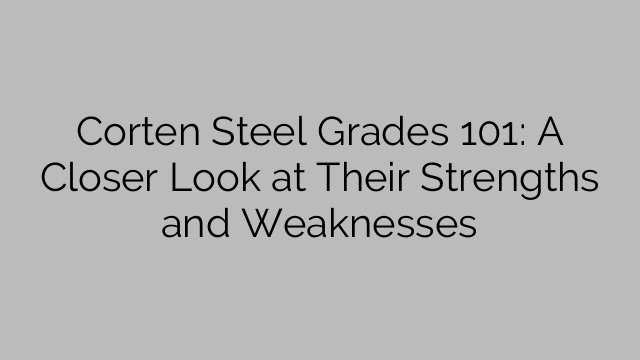Corten steel grades are primarily divided into two categories: Corten A and Corten B. These grades have different chemical compositions, with Corten A containing more copper, nickel, and chromium than Corten B. This variation in composition imparts distinct properties and characteristics to each grade.
One of the major strengths of Corten steel is its exceptional resistance to corrosion. The high copper content in Corten A creates a self-protective patina when exposed to the elements. This patina acts as a barrier, preventing further corrosion and enhancing the steel’s longevity. Consequently, Corten steel requires minimal maintenance and is often described as a “low-maintenance” or “maintenance-free” material.
Another strength of Corten steel is its high tensile strength, which makes it ideal for structural applications. It can withstand significant mechanical stress, making it suitable for buildings, bridges, and other load-bearing structures. Corten A, in particular, exhibits excellent weldability and formability, allowing for greater design flexibility and ease of fabrication.
Corten steel’s distinctive rusty appearance is also a significant selling point for many designers. Its rich, earthy color and rugged texture add a unique character to architectural projects, creating a sense of warmth and natural beauty. This aesthetic appeal makes Corten steel a popular choice for outdoor sculptures, landscaping elements, and artistic installations.
However, like any other material, Corten steel does have some weaknesses. One of the main concerns is its initial period of rusting, during which it may stain adjacent surfaces like concrete or asphalt. Additionally, the runoff from Corten steel in its weathering phase can stain other materials, such as stucco or stone. These staining concerns require careful planning and consideration during the installation process.
While Corten steel’s corrosion resistance is generally considered a strength, it can also be a disadvantage in certain applications. For instance, in highly corrosive environments, such as coastal areas with saltwater exposure, the protective patina may not form effectively, potentially leading to accelerated corrosion. In such cases, additional precautions, such as regular washing and maintenance, may be necessary to ensure the longevity of Corten steel structures.
In conclusion, Corten steel grades, specifically Corten A and Corten B, offer a range of strengths and weaknesses. Their superior corrosion resistance, high tensile strength, and unique aesthetics make them an attractive choice for various architectural and industrial applications. However, it is crucial to carefully consider the specific requirements and environmental conditions of each project to maximize the benefits and mitigate any potential weaknesses associated with Corten steel.
[ad_2]

